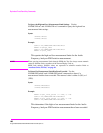
195
Equivalent Front-Panel Key Commands
To Set the Meter High End and Low End Points. Use the :METer:HEND and
:MEter:LEND commands to set the analog bar-graph meter’s high endpoint and
low endpoint.
Syntax
:METer:HEND <real number>
:METer:LEND <real number>
Example
OUTPUT 714;"MEAS:RFR:POW:MET:HEND 20"
OUTPUT 714;"MEAS:RFR:POW:MET:LEND 10"
This sets the analog bar-graph meter’s high endpoint to 20 watts and the
low endpoint to 10 watts for the TX Power measurement.
NOTE: When setting the value of the METER Data Function through GPIB, a
non-Attribute Unit unit-of-measure must be specified in the command string, otherwise the
current Attribute Unit is assumed by the Test Set. Refer to “Attribute Units (AUNits)” on
page 81.
To Query the Meter High End and Low End Points.
Use the :METer:HEND? and
:MEter:LEND? commands to query the analog bar-graph meter high endpoint and
low endpoint.
Syntax
:METer:HEND?
:METer:LEND?
Example
OUTPUT 714;"MEAS:RFR:POW:MET:HEND?"
ENTER 714;Meter_hi_end
OUTPUT 714;"MEAS:RFR:POW:MET:LEND?"
ENTER 714;Meter_lo_end
This queries the high end point and low end point of the analog bar-
graph meter for the TX Power measurement.
NOTE: When querying the value of the METER Data Function through GPIB, the Test Set always
returns numeric values in Attribute Units, regardless of the current Display Units or GPIB
Units settings. Numeric values are expressed in scientific notation. Refer to “Attribute
Units (AUNits)” on page 81.


















